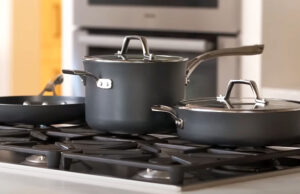As an Amazon Associate, I earn from qualifying purchases at no extra cost to you.
How to Install a Frigidaire Dishwasher (Expert Guide)
The old dishwasher finally gave up, leaving a pile of dirty dishes staring at me. I stared back, wondering if I could actually handle installing a new Frigidaire dishwasher myself. After a few hesitations, I rolled up my sleeves and discovered it wasn’t as tricky as I imagined. With a few tools, careful measurements, and a little patience, my kitchen was upgraded in a single afternoon. Could it really be this simple? Turns out, yes.
Before starting, measure your space carefully and remove the old appliance safely. Turn off the power and water supply to avoid accidents. Connect the water line, drain hose, and power supply according to the manual. Slide the dishwasher into place gently, ensuring it’s level and aligned. Secure it with screws and brackets, then test a short cycle to check for leaks or issues. Adjust the leveling if needed and enjoy your fully functional kitchen upgrade.
Prepare Your Space and Gather Tools
First, clear out the area under the counter where your dishwasher will go. Remove any old debris or obstacles to make installation smoother. I once found leftover screws from the previous owner, and those caused a tiny panic. You don’t want surprises like that. A clean, organized space saves a lot of stress later.
Next, gather the tools you’ll need: adjustable wrench, screwdriver, pliers, level, and Teflon tape. I keep them all in a small toolbox so nothing gets lost mid-install. Also, having a flashlight nearby helps if the space is dark. I remember fumbling under my sink once and swore I’d never do that again.
Check your water supply and electrical outlet. Make sure the water line and power source are within reach. Sometimes, the outlet is too far back or behind cabinets, which can cause frustration. I had to move mine slightly, and a small adjustment saved a lot of headaches.
Finally, read through the Frigidaire installation manual carefully. Don’t skim it, even if it looks obvious. I skipped one note once about the water line and spent an hour troubleshooting. Following instructions closely avoids unnecessary stress and ensures a smooth process.
- Clear the installation area completely
- Gather all necessary tools in one place
- Check water supply and electrical outlet
- Read the manual fully before starting
Disconnect Old Dishwasher Safely
Start by turning off the power to the old dishwasher at the breaker. I always double-check with a voltage tester just to be safe. Then, turn off the water supply valve under the sink. A small leak here can flood the kitchen, so caution is key.
Pull out the old dishwasher carefully. Sometimes, the bottom bracket or screws stick to the floor, so gentle wiggling helps. I once had to ask my neighbor for a hand, and teamwork made the process faster. Avoid pulling too hard to prevent scratching your cabinets or floors.
Disconnect the water supply line and drain hose next. Keep a small towel handy because some water often remains in the pipes. I remember that drip on my hand and laughed—it’s part of the process. Properly capping or removing hoses prevents leaks during installation.
Finally, remove the mounting brackets and any remaining screws. Check for any hidden debris or leftover clips that could block the new dishwasher. I found a plastic piece from the previous model, and it would have caused trouble later. A little extra inspection now saves frustration.
- Turn off power and water supply
- Pull out old dishwasher carefully
- Disconnect hoses and drain
- Remove mounting brackets and check for debris
Connect Water Supply Line
Attach the water line to the inlet valve at the back of your Frigidaire dishwasher. Wrap Teflon tape around the threads to prevent leaks. I’ve learned that skipping this step almost always leads to tiny drips that are annoying.
Use an adjustable wrench to tighten the connection, but don’t overtighten. I overtightened once and stripped the valve, costing extra time and a new part. Tight but gentle is the secret.
Make sure the water line isn’t kinked or bent when routing it under the sink. I once noticed a sharp bend and fixed it immediately. Smooth lines ensure steady water flow and prevent future leaks.
After connecting, turn on the water briefly to check for leaks before sliding the dishwasher fully into place. I watched a small drop appear once, tightened the connection, and it disappeared instantly. Early testing avoids bigger problems later.
- Wrap threads with Teflon tape
- Tighten water line gently
- Avoid kinks in hoses
- Test for leaks before full installation
Install the Drain Hose Correctly
Connect the dishwasher drain hose to the sink drain or garbage disposal. Make sure it forms a high loop to prevent backflow. I didn’t do this once, and dirty water crept back into the dishwasher. Not fun.
Secure the hose with a clamp or bracket as instructed in the manual. I always double-check the tightness by giving it a slight tug. Loose hoses are the most common reason for leaks.
Check the length of the hose to ensure it isn’t stretched or twisted. If it’s too long, coil it neatly without pinching. I remember fighting a twisted hose under my sink and learning that patience matters more than strength.
Finally, pour a small amount of water into the hose and run a short cycle to ensure smooth drainage. Observing it firsthand gives confidence that everything is set up correctly. Small tests like this save hours of troubleshooting later.
- Connect to sink drain or disposal
- Make a high loop to prevent backflow
- Secure with clamps or brackets
- Check for twists and test drainage
Slide and Level Dishwasher
Carefully slide the Frigidaire dishwasher into its space. I tip it slightly on one side while guiding it to avoid bumping cabinets. A friend once bumped mine, and a scratch reminded me to move slowly.
Check that the dishwasher is level using a carpenter’s level. I adjust the front and rear feet with small turns until it sits perfectly flat. Level machines work better and prevent doors from misaligning.
Ensure there is proper clearance around all sides. Too tight a fit can cause noise or make it difficult to open doors. I leave a small gap and it makes loading dishes easier every day.
Once in place, secure the dishwasher with screws through the mounting brackets to the countertop or cabinetry. I always double-check alignment before fully tightening. Proper attachment keeps it stable during heavy wash cycles.
- Slide dishwasher carefully
- Level with adjustable feet
- Leave proper clearance
- Secure with mounting screws
Connect Power and Test
For electric models, connect the power cord according to local codes. I always double-check polarity and grounding for safety. Mistakes here are risky, so careful attention pays off.
Turn on the circuit breaker and run a short test cycle. Listen for unusual noises and watch for leaks. I’ve caught small drips during tests and fixed them immediately. Early detection is key.
Check door alignment and make small adjustments if needed. A slightly misaligned door can cause incomplete sealing. I adjusted mine twice before everything looked perfect.
Finally, enjoy your clean kitchen and fully functional Frigidaire dishwasher. I poured a cup of coffee and watched it run the first cycle, feeling proud of doing it myself. It’s satisfying and saves money on installation.
- Connect power safely
- Run a short test cycle
- Adjust door alignment if needed
- Observe for leaks or unusual sounds
Final Thoughts
Installing a Frigidaire dishwasher can feel intimidating, but it’s manageable with careful preparation. Take your time measuring, connecting, and leveling everything. Small checks during each stage prevent major headaches. With patience and attention to detail, your kitchen upgrade will be smooth and rewarding. It’s a satisfying mix of hands-on work and instant results you can enjoy daily.
| Task | Tools Needed | Tips & Notes |
|---|---|---|
| Clear installation space | None | Remove old debris and check for obstacles |
| Disconnect old dishwasher | Wrench, screwdriver | Turn off power and water first |
| Connect water supply | Adjustable wrench, Teflon tape | Wrap threads, avoid overtightening |
| Install drain hose | Hose clamp, pliers | Make a high loop to prevent backflow |
| Slide & level dishwasher | Level, screwdriver | Adjust feet carefully, leave clearance |
| Secure appliance | Screwdriver | Tighten mounting screws after leveling |
| Connect power | Voltage tester, wire nuts | Follow local electrical codes |
| Test operation | None | Run short cycle, check for leaks & noise |
Frequently Asked Questions (FAQs)
Is it necessary to turn off water before installation?
Yes, turning off the water supply is essential. Even a small leak can flood your kitchen quickly. I once ignored this step and had a minor puddle under my sink. Closing the valve ensures safety while connecting hoses and prevents unexpected accidents. Always double-check the valve is fully closed before handling any pipes.
Can I install a Frigidaire dishwasher alone?
Yes, it’s possible to do it alone, though having an extra pair of hands helps. Sliding the dishwasher into place can be tricky in tight spaces. I’ve managed solo by tilting carefully and taking my time. If you can lift and maneuver it safely, following the manual and testing each connection ensures a smooth solo installation.
Do I need special tools for installation?
Mostly, common tools like a wrench, screwdriver, pliers, and level are enough. I keep Teflon tape and a flashlight handy as well. Specialized tools are rarely needed unless your kitchen has unusual plumbing or electrical setups. Staying prepared with standard tools usually covers all the necessary steps.
Is it okay to test without securing the dishwasher?
It’s fine to test short cycles briefly, but avoid running full cycles before securing it. I tested mine slightly while it wasn’t screwed in, just to check for leaks. This approach helps catch minor issues but always finalize attachment before regular use.
Can I use existing hoses from the old dishwasher?
Sometimes, yes, but it’s safer to use new hoses to prevent leaks or damage. My old hose was brittle and almost caused a drip. New hoses ensure proper fit, longevity, and compliance with Frigidaire’s installation recommendations.
Do I need a professional for leveling?
Leveling is simple with adjustable feet and a carpenter’s level. Professionals help if the floor is uneven or difficult to access. I did mine alone, adjusting front and back feet carefully. Proper leveling ensures smooth operation and prevents door misalignment.
Is testing for leaks really necessary?
Absolutely. I’ve caught tiny drips during the test cycle that I would have missed otherwise. Testing early prevents water damage and ensures all connections are tight. It’s a small time investment with huge peace of mind.
Can I adjust the door after installation?
Yes, most Frigidaire models allow minor door adjustments. I realigned mine twice to ensure it closed perfectly. Checking after initial tests helps avoid future issues with sealing and ensures your dishwasher works efficiently.



